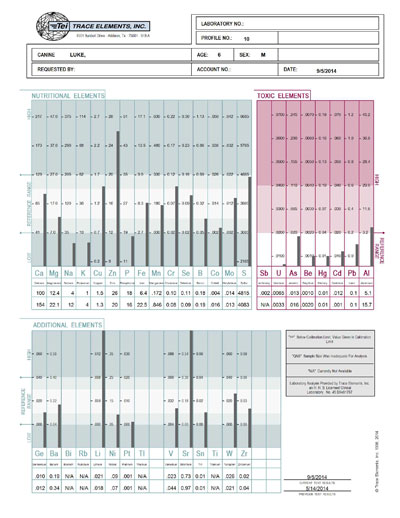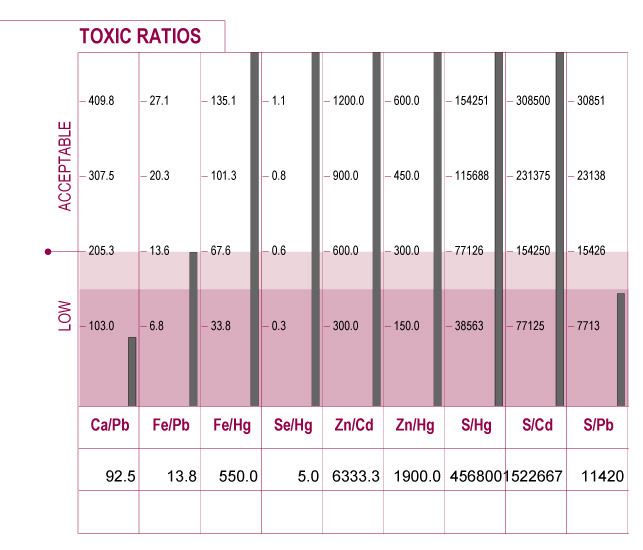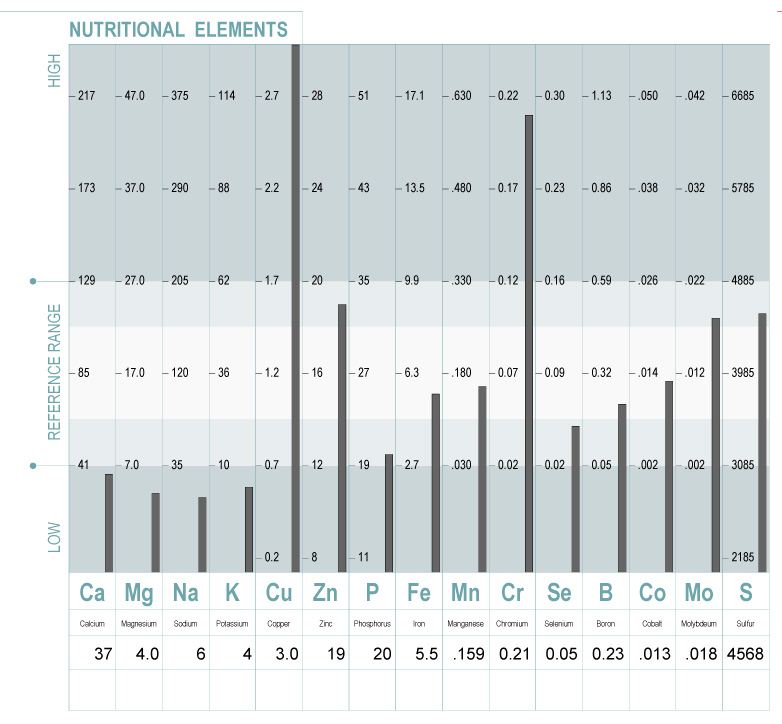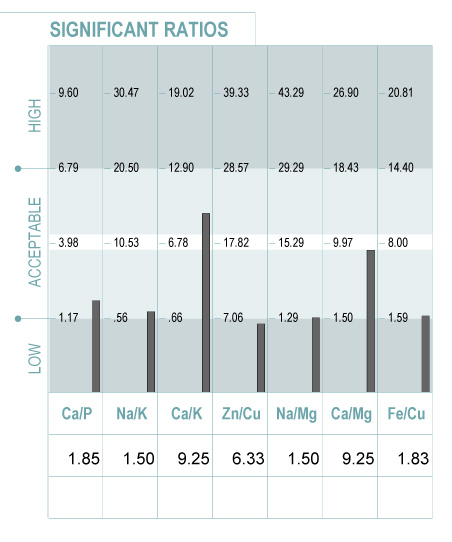Update: 14 May 2024
Canine hTMA (example)
hTMA uses hair tissue for analysis. Hair tissue is preferred because it is a stable, providing a record of several months of biochemical activity. Obtaining a sample is non-invasive and can be done without the need of veterinary intervention.

A Canine hTMA lab test is a comprehensive assay method that provides detailed information about your dog's health. It includes nutritional elements, siginificant mineral ratios, endrocine function and performance ability. hTMA is an effective toxicity screen, indicating toxic elements and toxic ratios.
Noninvasive Assay Method for Carnivores
Physical, biochemical and emotional stressors deplete the body of essential nutrients. Chronic illness develops in stages over time, and environmental illness is result of exposure to environmental toxicity. These combined health assaults result in the accumulation of toxins in tissue and disrupt normal body chemistry.
The hTMA lab test quantifies deficiences or excesses in essential mineral levels and ratios, and identifies toxic heavy metals of concern. A comprehensive lab report uses charts, graphs and supportive documentation to show metabolic status, and provides corrective recommendations to address mineral imbalances, reverse physical degeneration and revitalize cellular metabolism (energy).
- Progress Evaluation Re-test
After two (2) to six (6) months, a re-test is recommended to evaluate progress. Re-test results highlight the improvements made from the corrective protocol, and other biochemical changes that may have occured. Consequently, to ensure continued improvement an updated protocol which reflects these changes will be recommended. Also important, the re-test addresses possible adverse reactions due to toxin mobilization and removal. And the readjustment of essential mineral interrelationships. In short, re-testing is a safe and effective method for monitoring detoxification.
Canine hTMA Report (example)
Important areas of the report are described below and include:
- Toxic Elements
- Toxic Ratios
- Nutritional Elements
- Significant Ratios
- Endocrine Index
- Performance Index
- Supplement recommendations
- Bonus: Feeding recommendations
- Canine hTMA Instructions
Toxic Elements
The toxic elements section displays the results for each of the reported toxic elements. These elements can enter the body through inhalation, intestinal absorption and even be absorbed through the skin, depending upon their chemical form. Since it is acknowledged that there are no safe levels of the toxic heavy metals tested, it is preferable that all levels be as low as possible and within the white reference section. Any test result that falls within the upper colored area should be considered as statistically significant, but not necessarily clinically significant. Further investigation may then be warranted to determine the possibility of actual clinical significance and steps can be taken to mitigate exposures. These toxic elements are well-known for their interference upon normal biochemical function and are commonly found in the environment and therefore are present to some degree in all biological systems. However, these metals clearly pose a concern for toxicity when tissue accumulation occurs to excess.

Toxic Elements: This chart shows a measurable level of mercury, high tissue lead and aluminum levels, and a significantly high arsenic level. Arsenic is number one on the ATSDR's 2011 Priority List of Hazardous Substances. (Lead is #2 and mercury is #3.) Arsenic is a known carcinogen and affects the skin, digestive system, liver, nervous system and respiratory system. Arsenic compounds can create reactions in the body that disrupt enzymes that are involved in respiration of cells, fat and carbohydrate breakdown and their metabolism. The accumulation of toxic levels of arsenic can result in paralysis, coma, cardiovascular collapse and death. Aluminum is the most common toxic element found at high levels in hTMA assessments of dogs. Aluminum has been described as a protoplasmic poison and a pernicious and persistent neurotoxin. While the body is able to excrete aluminum in its natural form, the element, like mercury, is toxic to all life forms when concentrated in their tissues. It has a tendency to accumulate in the brain and nerve tissues and in the bones and teeth. Followup hTMA re-tests revealed that the mitigation, dietary and supplement changes made continued to bring tissue toxin levels down, along with health improvements in the dog.
Toxic Ratios
All animals are exposed to toxic metals to some degree. The retention of these toxic metals, however, is dependent upon the animal's susceptibility. The balance of the protective nutrient minerals within the body in relation to the heavy metals can frequently be the determining factor to this susceptibility. By examining the toxic metal levels in relation to the protective minerals, the extent to which the heavy metals may be involved in abnormal chemistry can frequently be seen. This is done by examining the toxic ratios.
Each toxic metal ratio result should be in the upper white area of the graph, and the higher the better. Toxic ratios that fall within the darker red area may indicate an interference of that toxic metal upon the utilization of the nutritional element.
The concentration of lead in polluted air varies inversely with altitude. Because lead is a heavy element, it settles out of the air onto the ground. Consequently, lead poisoning occurs frequently in dogs who spend their lives close to the ground. Epilepsy can result from lead toxicity in dogs. In young children, hyperactivity may be the first presenting symptom, so if you have a hyperactive dog you can suspect high tissue lead levels. Other emotional symptoms of a lead body burden include aggression, violent behavior, antisocial behavior, poor concentration or learning capacity.

Toxic Ratios: This chart indicates inadequate levels of calcium (Ca), iron (Fe) and sulfur (S) relative to lead (Pb). This means that the dog does not have enough of these nutrient minerals to protect against tissue accumulation of lead. Lead can be found in all parts of our environment. Much of it comes from human activities including burning fossil fuels, mining, and manufacturing.
Nutritional Elements
The nutrient minerals have been studied extensively, are well defined and considered essential for many biological functions. They play key roles in such metabolic processes as muscular activity, endocrine function, reproduction, skeletal integrity and overall development. This section of the report shows nutritional mineral levels that may reveal moderate or significant deviations from normal. The light blue area of the graph's mineral levels represent the established reference ranges as determined from statistical analysis of healthy canines. A mineral level that is outside the reference range can be identified.

Nutritional Elements: This chart shows excess copper (Cu). Copper is classified as a sedative mineral. In excess, copper may decrease optimum performance, due to its suppressing effect upon endocrine activity, especially the thyroid gland which is responsible for sustained energy production. Since copper water pipes are used in most modern buildings, one of the most common sources of excessive copper intake is from water.
Significant Ratios
If the synergistic relationship (or ratio) between certain minerals is disturbed, studies show that normal biological functions and metabolic activity can be adversely affected. The light blue area of the graph's mineral ratios represent the established reference ranges as determined from statistical analysis of healthy canines. A mineral ratio that is outside the reference range can be identified. Even at extremely low concentrations, the synergistic and/or antagonistic relationships between minerals still exist, which can indirectly affect metabolism, cellular energy and the stress response.

Significant Ratios: This example shows several ratios near or just outside of the established reference range. A healthy dog will have all ratios near the center (white area) of the graph reference range. The Ca/K and CA/Mg ratios on this graph would be considered healthy. Each ratio represents different metabolic functions and can identify trends toward health problems. The report will identify and explain any ratios that are outside of the reference range, and provide recommendations for correcting the imbalance.
Endocrine Index

Endocrine Index: The thyroid gland is responsible for cellular energy production and release. The graph reflects thyroid activity within the normal range and low adrenal activity. The adrenal gland produces a number of vital hormones, many of which have an effect upon energy production.
The endocrine index is a presentation of the pituitary-adrenal-thyroid relationship, commonly known as P.A.T. axis. These endocrine glands influence energy production on a cellular level and ultimately the health and performance of the dog. Ideally, there should be a balance within the P.A.T. The levels need not be at the ideal range as this range is used only as a reference point. However, they should be balanced above, below or at the ‘ideal’ point. A major deviation between the P.A.T. axis can be indicative of a tendency or trend toward an adverse health condition. In the performance animal, a major deviation of the P.A.T. axis is reflective of an adverse affect upon speed and/or stamina.
A balanced P.A.T. would appear on the following index with all three bar graphs extending the same length to the right. Ideally, all three would extend to the mid-way point, but as mentioned previously, a balance anywhere within the box is acceptable.
Performance Index
The performance index shows the relationship of the energy producing glands (thyroid and adrenal) and their effect on speed and endurance.

Performance Index: This example reflects the domination of the thyroid gland over the adrenal glands. This indicates endurance over long distances or for longer periods of time. However, speed, quickness and power over short time periods or distances are affected negatively.
Supplement Recommendations
Essential nutrient minerals are required for proper growth, development and physiological functions. Your dog's body cannot synthesize these minerals, so they must be obtained from their diet. Supplement recommendations are provided to help correct and improve mineral levels and ratios. The purpose of the recommendations are to re-establish a normal balance of body chemistry through individually designed diet and supplement suggestions. By improving your dog's mineral levels and ratios, you will enhance its ability to utilize the nutrients efficiently and resulting in improved energy production and health.
Bonus: Species appropriate feeding recommendations
As a bonus, we include general species appropriate dietary recommendations with instructions for preparing your dog's food at home.
Canine hTMA Instructions
Taking the sample is non-invasive (safe) and easy to do. Download step-by-step instructions.
- Canine hTMA $125
- Canine Re-test $125 (progress evaluation)